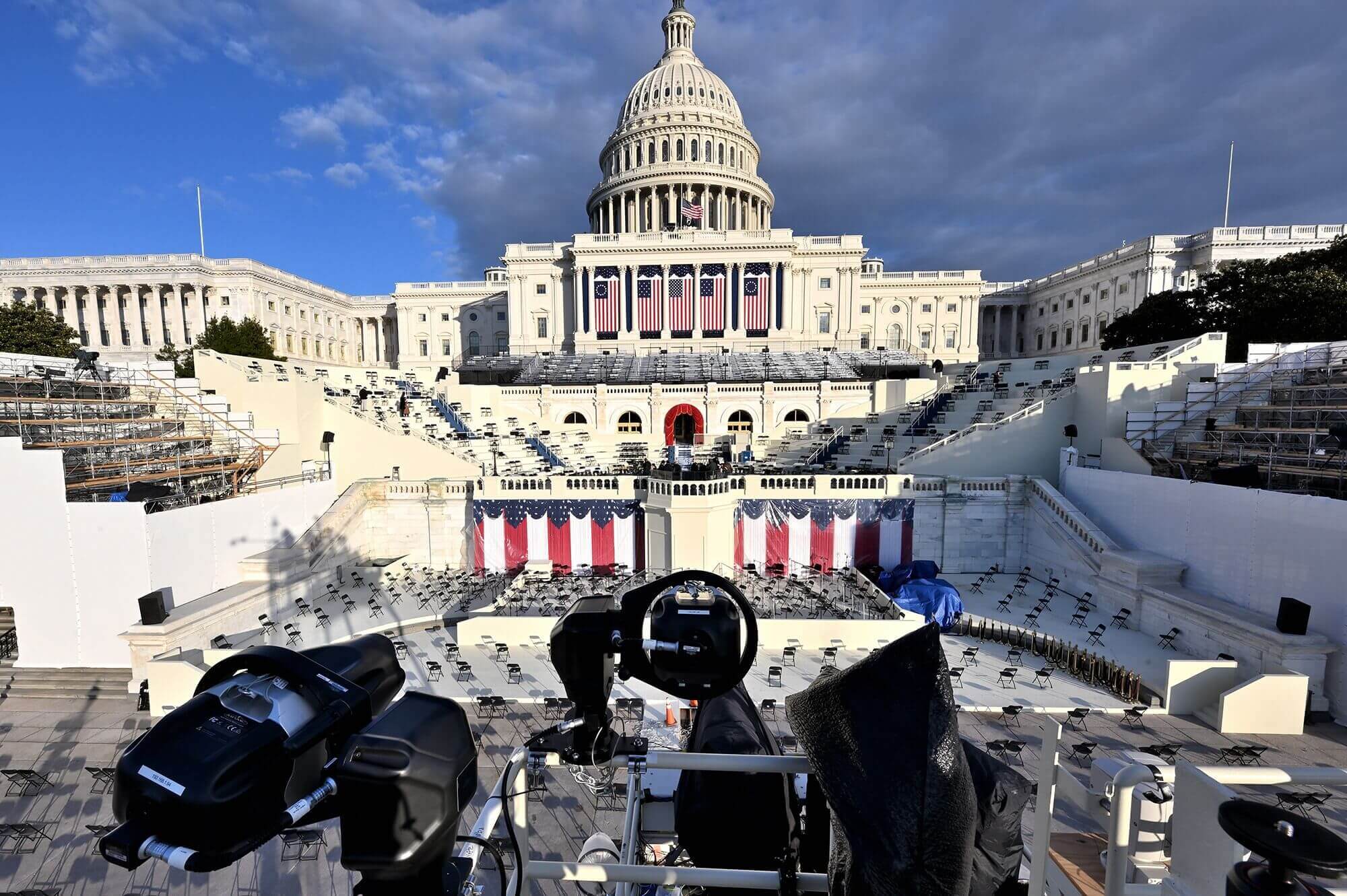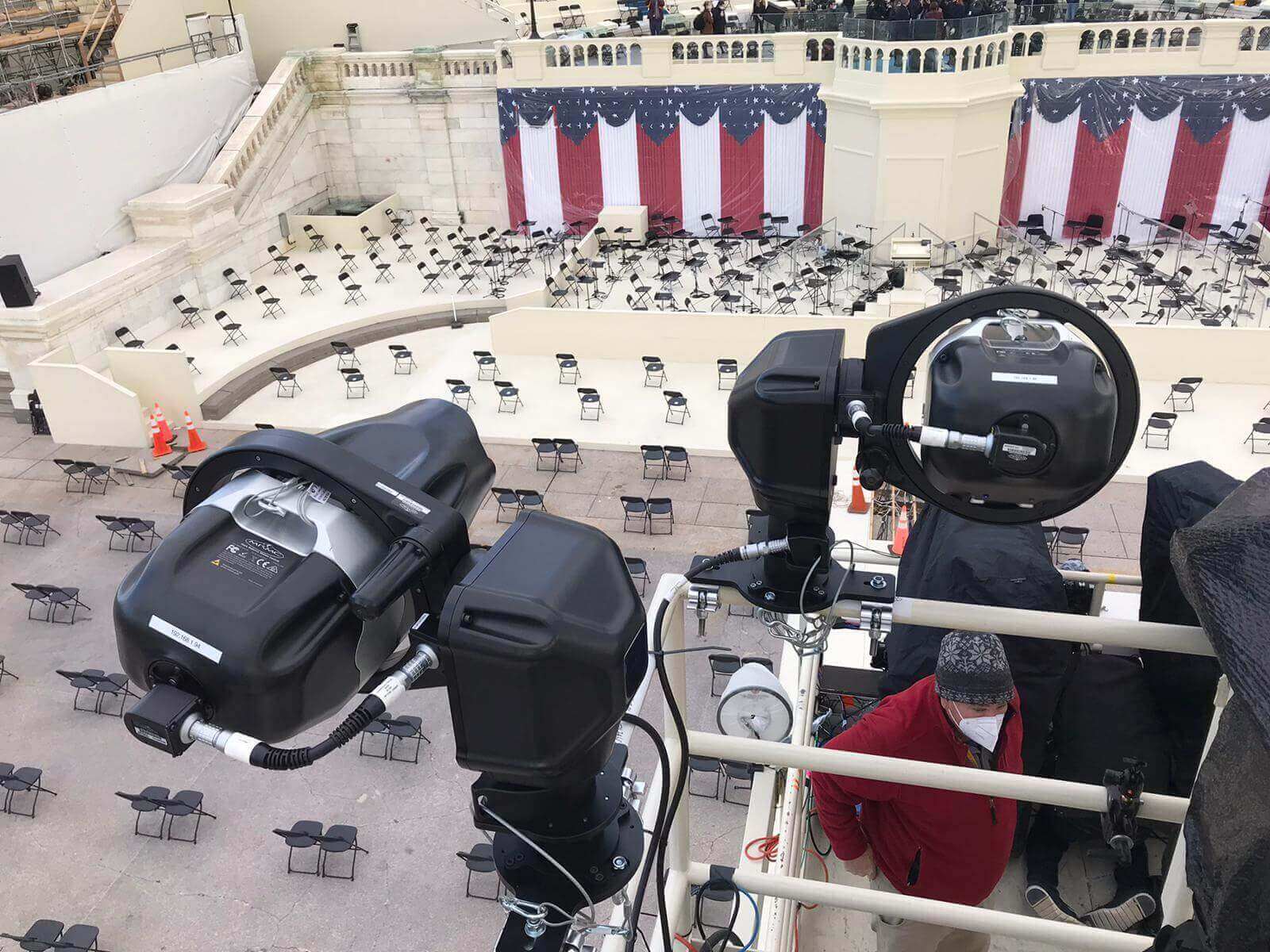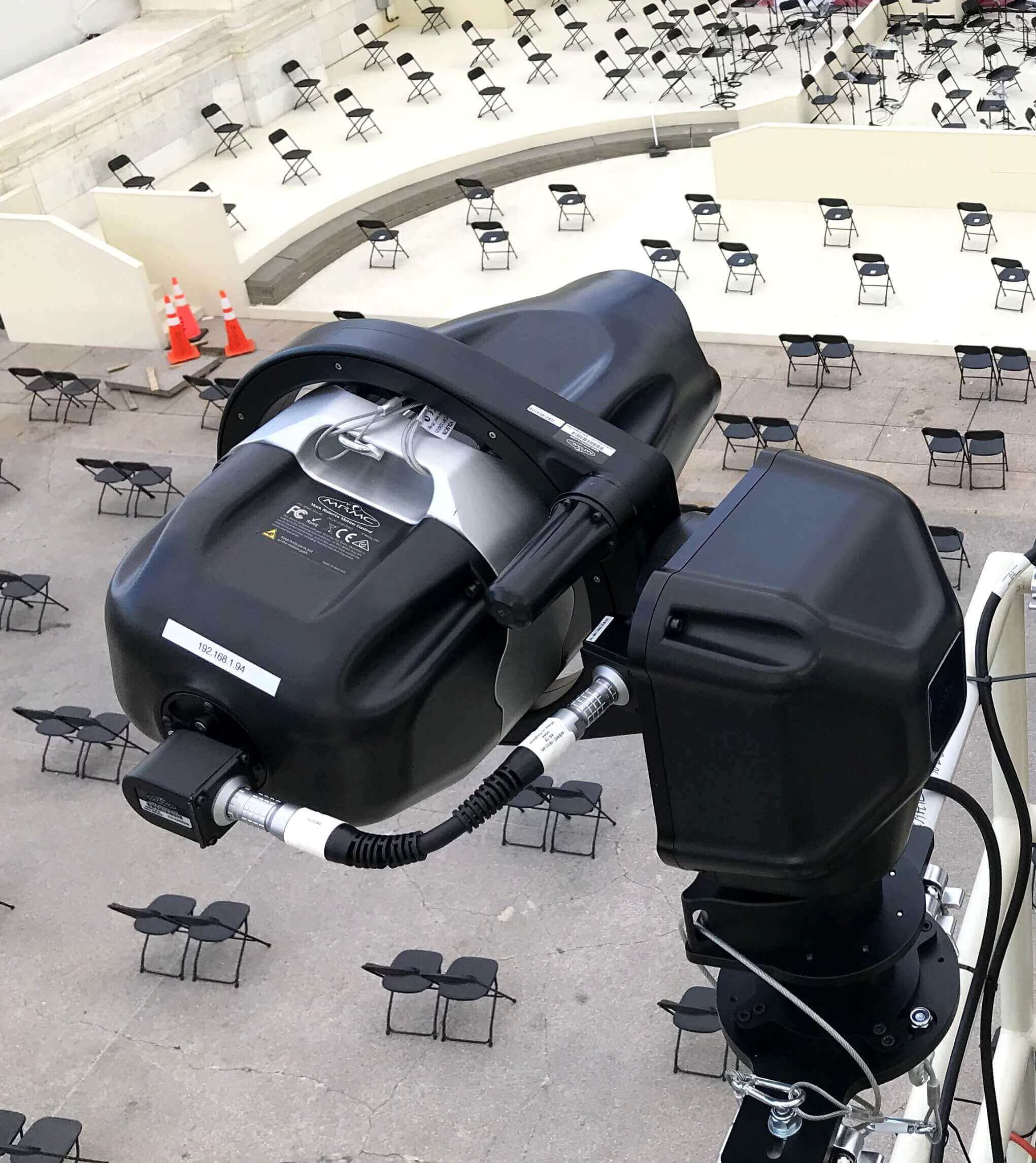MRMC puts Robotic Pod Cameras where photographers aren’t allowed to go
Robotic Pods Capture the Inauguration of the new President
We were very proud and excited to have our Robotic Pods cover the recent inauguration of the new president. Our Pod systems are specifically designed to be placed in locations where camera operators cannot access and controlled remotely. To learn more about the project and our Robotic Pod system, read the interview with DP Review.
Interview Taken from DP Review
How do you cover an event where photographers aren’t allowed? Last month saw the inauguration of Joe Biden as president of the United States, an occasion which would normally see huge crowds of people, from officials, politicians and members of the public, to representatives of the world’s press.
Obviously that wasn’t going to happen this time around, and after the storming of the Capitol Building by a pro-Trump mob on Jan 6th, it became even more clear that Biden’s would be an inauguration like no other.
UK-based and Nikon-owned company MRMC has been creating robotic solutions for event photography for years, putting cameras where it wouldn’t be safe – or permitted – for photographers to go. Since the global pandemic started to bite last year, their remote camera pods have been popping up all over the place, including at the US Capitol on January 20th. To find out more we spoke recently to Sascha Kunze, Broadcast Services Director at MRMC, and Molly Riley, Technical Solutions Manager at Nikon Inc.

The following interview has been edited lightly for clarity and flow.
What Does MRMC Do?
SK: We have a team of people that supports photographers all over the world, with remote photography solutions. So we design and manufacture the pods that you’ve probably seen installed at various events, including the recent presidential inauguration in the US.
How are robotics used now?
MR: in the context of imaging, we’ve been able to use the robotic pod that MRMC designed in certain locations in the same way as static, remote cameras, where photographers can’t be present. They allow photographers to have more creative control in those locations, and shoot from different vantage points.
Is that a new requirement? Or has the technology only recently become available to meet an existing need?
SK: There’s been a need for remote control for quite some time, and we’ve supported a lot of events now, where there’s been a requirement to put cameras where humans can’t go, like the beams in a roof structure for example. With our pods you can control the camera angle and reframe from that position, whereas with a traditional static camera it would just be guesswork.
We didn’t have a plan for COVID, I don’t think anyone did. But there has definitely been a need this year for photography with social distancing taken into account, too. Because of the global situation over the past year, we’ve continued to develop the product to make everything COVID-safe.

Your team just recently installed cameras to cover the presidential inauguration. Clearly it was a very different kind of inauguration this year, how long were you planning for the event?
MR: We started planning for the inauguration back before COVID, when we were looking at various different scenarios and different angles for the various news agencies covering the conventions. The MRMC pods hadn’t been used for conventions before so we were in planning for that. And as the conventions got whittled down because of COVID, the robotics became more important, because we could put a robotic pod in a place that a photographer was no longer allowed to go.
We started thinking about how we could help capture the imaging that everybody wants, but without having photographers present
Pre-COVID, our plan for the conventions was to have the pods up in the lighting trusses in the roof, for a different viewpoint. Then that changed, and we were going to position the pods in areas where only a pool photographer was allowed to be. We were working on that plan when the conventions were canceled altogether.
Then we started to think ahead to the inauguration, because we knew access would be very limited. So we started thinking about how we could really help to capture the imaging that everybody wants, but without having photographers present behind the cameras.
Obviously you’ve been working on this for a long time, well before the storming of the Capitol in early January – did the events of Jan 6th affect your planning?
MR: The only thing that changed was the additional security. The planning for this inauguration was always quite last-minute, with changes being made constantly. The events of the 6th definitely increased security concerns, but the original plan still went ahead.
At the inauguration, where were the pods and the camera operators?
MR: We had three pods, and they were all on the center stand. That center stand normally holds about 11 camera positions, which was significantly reduced, restricted to only a small number of media and official government personnel. Two of the photographers using the pods were in a trailer on-site, and a third was inside the Dirksen Senate Office Building, with their own exclusive network. The other operators were in the media compound to the right of the steps and the inaugural platform. So they were approximately 200 feet from the stand where the cameras were located.
At the PyeongChang Winter Olympics, the photographers were in the press center, taking photographs of the coastal compound, 70 miles away
SK: At previous events we’ve operated over far greater distances. For example we had them at the PyeongChang Winter Olympics, and the photographers were in the main press center, taking photographs of the coastal compound, 70 miles away. It all depends on network infrastructure. We could, for example, (and have) operated the pods from the other side of the world.
How adaptable are the pods in terms of what cameras and lenses will fit in them?
MR: The pods that we used at the inauguration had a D5 in them with an 80-400mm lens, and there are pods available for mirrorless cameras as well, depending on the client’s needs. There are five different lens configurations, so we can go from 24mm all the way to 500mm.
This is a perfect time to come up with creative solutions for remote working – has this technology been given a boost as a consequence of the global COVID situation?
SK: Absolutely, from our perspective we’ve seen a huge increase in the number of enquiries. And looking ahead at some of the events coming up, we’re definitely planning on rolling out a lot more robotics, and making them available to any photographers, really, to help them at events and to create a safe environment while still capturing the event. So you could use them at any event, even a wedding.

When you have the remote pods set up, how does it work? How are you actually capturing images?
SK: Inside every pod is a Nikon camera with a Nikon lens. We’ve created a software solution that interfaces with the cameras, which gives full control over all of the standard controls. So even if you’re operating the camera from far away you have the feeling of looking through a viewfinder. You have all of the operational information that you’d get if you were on the ground, but it’s just done over ethernet. The photographer uses our software, called MHC, which stands for Multi-Head Controller software, to operate the pod. And you’ve got all the shooting controls.
How many pods would one photographer be operating?
SK: It really depends on the use-case, but at a typical event we’ve found that in most cases, it’s usually 1:1, so one photographer per camera.
Do you do any automatic or scheduled triggering, or is it all manual remote operation?
The idea is that we give the operator a remote capability, so at this point the pods are not automated. There’s still someone sitting there creatively controlling what the robot is doing and firing the shutter. All we’re doing is adding distance.
A lot of photographers reading this interview are probably thinking ‘oh no, something else that’s going to put me out of a job!’ Do you think that the 1:1 relationship between camera and photographer will continue to be important?
SK: That’s a very real worry, but we do see it as a 1:1 relationship. The robots don’t make the creative decisions – that’s still done by a human. Those special moments that they’re trying to capture, that’s something a photographer has to decide on and look for. I think giving photographers an additional creative ability is a positive. To go back to talking about PyeongChang, there were some events in the evening where the temperature dropped to minus 25C, and we were able to give the photographers the ability to shoot from a warm office.
MR: It’s important to add that with so many outlets now, and so much demand for coverage, agencies want more and more content. So this solution gives them the ability to do that. They’ll be able to shoot from angles that they wouldn’t otherwise be able to.
How are you planning for major events this year? Obviously the Olympics being the main one.
SK: Our planning for the Olympics started long before COVID hit. We actually started planning right after the last Olympics. Press agencies and photographers are allowed onsite visits during the preparation phase, to see where they can shoot from, what the angles are and what lenses they’ll need. We work with photographers to help them understand what robotics are capable of, and also what they need, so that we can develop solutions.
We’re planning on the assumption that the Olympics will go-ahead
A lot of our customers who were involved in those initial conversations, we’re still talking, plans are still moving forward, and they’ve made additional robotics requests since then. So we’re ramping up, and our original plans are largely unchanged. We just make sure that the network infrastructure is in place, and the customers have all the technical information they need to build their setups.
We’re planning on the assumption that the Olympics will go ahead, but the robots are so flexible that we can be ready at very short notice.
How important are solutions like this, strategically for Nikon?
MR: I can’t speak on behalf of the company as a whole, but we enjoy having an additional avenue for capturing images. It’s adding to the tools available for our photographers, and it’s important to be able to offer more and more solutions. We have robotic pods up at Fenway Park, for example, for the Boston Red Sox. They can’t put photographers there because of COVID, so they decided to use the pods.
In general terms, where do you see this technology going in the future?
SK: Take the soccer world cup. The roof structures in the stadiums are no-go zones for humans. So you have to have robots there. And because you have the creative control with the robotics, the need is going to increase for creative angles looking at formations or getting the action from behind the goal and reframing to get crowd celebrations, for example. Those editorial images are really striking, and photographers are realizing that they can get cleaner shots and angles that haven’t been seen before.
We’re constantly talking to our customers and we have a lot of bookings already for big events that are coming up
At red carpet events, for example, you can put a camera in the lighting trusses, and get your subject surrounded by carpet. We’re constantly talking to our customers and we have a lot of bookings already for big events that are coming up. There’s a huge demand, so we’ll probably have to manufacture more hardware at some point!
We’ve been at the Olympics, we’ve been at the soccer World Cup, we’ve been at the Australian Open, the Commonwealth Games, and at Wimbledon, at film premieres, and at so many events around Europe. I couldn’t list them all, but that gives you some idea of the events that we’re doing. We’re continuing to grow year over year, and motion control is a key part of our strategy at MRMC.
To learn more about the Robotic Pod click here
